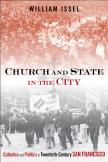Allies for Justice
Those for whom San Francisco represents a leftist and left-coast city may be surprised to learn, as William Issel contends was true for the century from 1890 to 1990, that it would be difficult to exaggerate the importance of the Catholic Church to San Francisco politics and culture. For much of that period, few important decisions were made without passing them through the chancery office. Although San Francisco Catholics made up only a third of the city’s population, they amounted to 68 percent of church-goers. In a city born abruptly from the Gold Rush and the later silver bonanzas, Catholics and Jews were from the beginning among the magnates and trailblazers. Unlike their position in eastern cities, they did not have some kind of initial second-class citizenship. Catholics have provided far and away more San Francisco mayors than any other denomination.
From 1890 on, Catholics sought to influence the debates about the common good of the city. Catholics, who were largely working-class Irish, Germans and Italians, fought for equity in the workplace and for equality of the working class in the councils of government. Catholics worked to limit unilateral business power. A rich Catholic mayor in the 1890s, James Phelan, helped pass a city charter in 1898 that mandated public ownership of the utilities, a minimum wage, maximum working hours and the right to citizen-initiated referendums and initiatives. San Francisco’s Pacific Coast Laborers’ Union sent the first American public acknowledgement thanking Pope Leo XIII for his encyclical “Rerum Novarum.”
In a huge dock workers’ strike in 1901, the Rev. Peter Yorke spoke at the strike rally and met secretly with the governor of California, Henry Gage, to ward off any martial law enactment against the strikers. Archbishop Patrick Riordan made Labor <\#000>Day a central church celebration. In another strike in 1916, Archbishop Edward Hanna served on an impartial wage board arbitrating the strike “to prevent labor from getting a rough deal.” Major strikes on the waterfront in the 1930s pitted Communists (including Harry Bridges) against those Catholics and industrialists who opposed the strikes. Catholics insisted that even if there was some Communist influence in Bridges’s union, the strikers nevertheless had legitimate grievances.
In the tumultuous 1930s, Catholics rallied in large numbers to celebrate the feast of Christ the King. In 1934, 50,000 came to a large rally-Mass. A strong San Francisco local unit of the Association of Catholic Trade Unionists sponsored rallies against communist influence, but also took the lead in attacking anti-Semitism. Archbishop John Mitty broadcast a radio message attacking Kristallnacht, and Catholics took the lead in sponsoring a conference for Christians and Jews. The Communists themselves infiltrated A.C.T.U. meetings to find out why Catholics were so successful in winning union elections around the notion of unionism on Catholic principles. Hugh Donohue, who edited the Catholic newspaper, The Monitor, supported the closed shop. The University of San Francisco’s Labor Management School (in explicit competition with the Communist-backed California Labor School) trained 5,000 union members and management personnel.
In the late 1950s, Catholics joined the fight for liberal racial reform. Local units of the Catholic Interracial Council fought against propositions that favored racially restricted housing. Issel documents how Catholics fought for a notion of the common good that included not just rights but responsibilities and that honored workers’ rights as well as property rights. Several of San Francisco’s major political figures, the congressman and later mayor Jack Shelley and Mayor Joseph Alioto, were more than just nominal Catholics. They had deeply imbibed Catholic social teaching. Alioto had served under Msgr. Francis Haas when Haas was under secretary of the United States Department of Labor and later served on the Fair Employment Practices Commission.
With the influx of hippies in the 1960s, gays in the 1970s and dot-com workers in 2000, the cultural setting and demographics of San Francisco politics shifted. Supervisors came to be elected by districts, not city-wide. Issel notes the shifts during the administrations of the Catholic mayors Joseph Alioto and George Moscone, who were both still dedicated to a larger notion of the common good and fought for fair housing and equitable redevelopment projects. He notes:
Increasingly—although not without resistance from those still committed to the old order—San Franciscans would make politics and policy according to a vision of the common good premised on unlimited individual rights, unbounded individual freedom of choice and government activism on behalf of rights, not duties; entitlements not obligations; diversity not unity. The Catholic Church and Catholic lay activists continued to participate in this new political order, typically adopting a strong liberal orientation on issues of economic justice and questions of war and peace, side by side with an equally strongly conservative stance on cultural issues.
Although Catholics still remain well represented in judgeships and supervisory positions, and as mayors (Gavin Newsom until 2010), police chiefs and fire chiefs, their clout is now much diminished. It is not likely that many issues will now pass through the chancery office. Issel’s book represents a fairly new and intriguing thrust among historians to chart religion and politics at local municipal levels; and it gave me a strong feeling of déjà vu with its stories about people and events I so well knew.
This article also appeared in print, under the headline “Allies for Justice,” in the May 27, 2013, issue.








